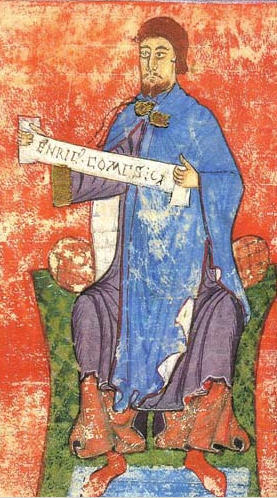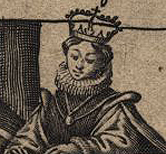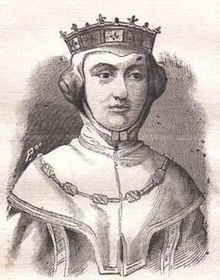
Afonso I, also called Afonso Henriques, nicknamed the Conqueror and the Founder by the Portuguese, was the first king of Portugal. He achieved the independence of the County of Portugal, establishing a new kingdom and doubling its area with the Reconquista, an objective that he pursued until his death.

Afonso II, nicknamed the Fat or the Leper, was the third king of Portugal and the second but eldest surviving son of Sancho I of Portugal and Dulce of Aragon. Afonso succeeded his father on 27 March 1211.

Afonso IV, called the Brave, was King of Portugal from 1325 until his death in 1357. He was the only legitimate son of King Denis of Portugal and Elizabeth of Aragon.

Sancho I of Portugal, nicknamed "the Populator", King of Portugal was the second but only surviving legitimate son and fifth child of Afonso I of Portugal by his wife, Maud of Savoy. Sancho succeeded his father and was crowned in Coimbra when he was 31 years old on 9 December 1185. He used the title King of Silves from 1189 until he lost the territory to Almohad control in 1191.

Peter I, known as the Just or the Cruel, was King of Portugal from 1357 until his death.

Theresa was Countess of Portugal, and for a time claimant to be its independent Queen. She rebelled against her half-sister Queen Urraca of León. She was recognised as Queen by Pope Paschal II in 1116, but was captured and forced to accept Portugal's vassalage to León in 1121, being allowed to keep her royal title. Her political alliance and amorous liaison with Galician nobleman Fernando Pérez de Traba led to her being ousted by her son, Afonso Henriques, who with the support of the Portuguese nobility and clergy, defeated her at the Battle of São Mamede in 1128.

Henry, Count of Portugal, was the first member of the Capetian House of Burgundy to rule Portugal and the father of the country's first king, Afonso Henriques.

Constanza Manuel of Villena, was a Castilian noblewoman who by her two marriages was Queen consort of Castile and León and Infanta of Portugal.

Elizabeth of Aragon, more commonly known as Elizabeth of Portugal, was queen consort of Portugal who is venerated as a saint in the Roman Catholic Church.

Urraca of Portugal was the queen of León from 1165 until 1175 as the wife of King Ferdinand II. She was the daughter of the first Portuguese king, Afonso I, and the mother of Alfonso IX. After her marriage to Ferdinand was annulled, the former queen became a nun.

Sancha of Portugal, was a Portuguese infanta, second daughter of King Sancho I of Portugal and Dulce of Aragon.

Branca of Portugal was a Portuguese infanta (princess), eighth child of Portuguese King Sancho I and Dulce of Aragon, was probably the twin sister of Berengaria, she was raised in the court with her father and his mistress "a Ribeirinha" and, when she was eight or ten years old, was sent to live with her sisters at the Monastery of Lorvão. She was a nun at a convent in Guadalajara and was interred at the Monastery of Santa Cruz in Coimbra where her mother was buried.

Eleanor of Portugal, was a Portuguese infanta by birth and Queen of Aragon from 1347 to 1348 as the second wife of King Peter IV.
Maria of Portugal was a Portuguese infanta (princess) member of the House of Burgundy and by marriage Marchioness of Tortosa and Lady of Albarracín.

Matilda of Savoy was Queen of Portugal, after her marriage to King Afonso Henriques, the first sovereign of Portugal, whom she married in 1146.

Eleanor of Aragon was Queen of Portugal from 1433 to 1438 as the spouse of King Edward. After Edward's death, she served as regent in 1438-1440 for her son Afonso V. She was the daughter of Ferdinand I of Aragon and Eleanor of Alburquerque.

Beatrice of Castile or Beatriz was an infanta of Castile, daughter of Sancho IV and María de Molina. She was Queen of Portugal from the accession of her husband, Afonso IV, in 1325 until his death on 28 May 1357.

Mafalda of Portugal was a Portuguese infanta, the fourth legitimate child and third daughter of Afonso Henriques and his wife Mafalda of Savoy.

Isabella of Urgell, Duchess of Coimbra was a Catalan noblewoman of the Urgell branch of the House of Barcelona. She was the wife of Infante Peter, Duke of Coimbra.

The County of Portugal refers to two successive medieval counties in the region around Guimarães and Porto, today corresponding to littoral northern Portugal, within which the identity of the Portuguese people formed. The first county existed from the mid-ninth to the mid-eleventh centuries as a vassalage of the Kingdom of Asturias and the Kingdom of Galicia and also part of the Kingdom of León, before being abolished as a result of rebellion. A larger entity under the same name was then reestablished in the late 11th century and subsequently elevated by its count in the mid-12th century into an independent Kingdom of Portugal.



















